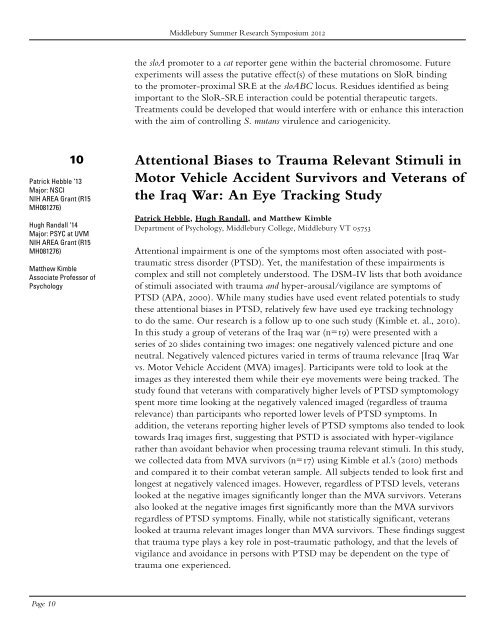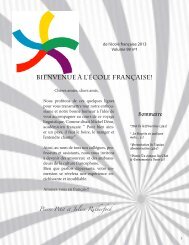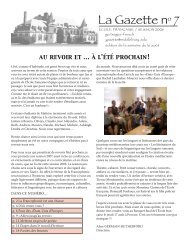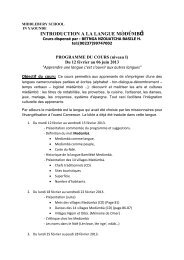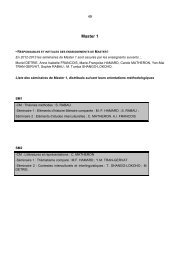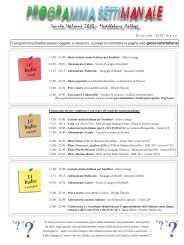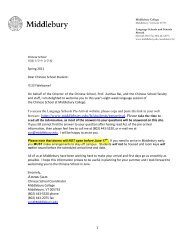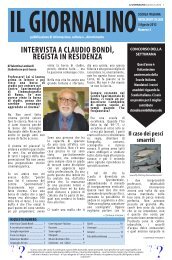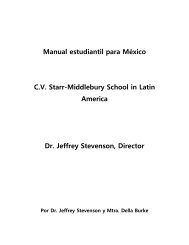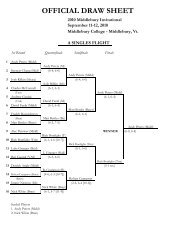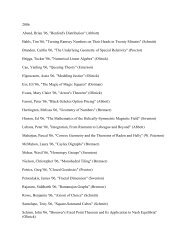2012 Summer Symposium Program - Middlebury College
2012 Summer Symposium Program - Middlebury College
2012 Summer Symposium Program - Middlebury College
You also want an ePaper? Increase the reach of your titles
YUMPU automatically turns print PDFs into web optimized ePapers that Google loves.
Page 10<br />
10<br />
Patrick Hebble ‘13<br />
Major: NSCI<br />
NIH AREA Grant (R15<br />
MH081276)<br />
Hugh Randall ‘14<br />
Major: PSYC at UVM<br />
NIH AREA Grant (R15<br />
MH081276)<br />
Matthew Kimble<br />
Associate Professor of<br />
Psychology<br />
<strong>Middlebury</strong> <strong>Summer</strong> Research <strong>Symposium</strong> <strong>2012</strong><br />
the sloA promoter to a cat reporter gene within the bacterial chromosome. Future<br />
experiments will assess the putative effect(s) of these mutations on SloR binding<br />
to the promoter-proximal SRE at the sloABC locus. Residues identified as being<br />
important to the SloR-SRE interaction could be potential therapeutic targets.<br />
Treatments could be developed that would interfere with or enhance this interaction<br />
with the aim of controlling S. mutans virulence and cariogenicity.<br />
Attentional Biases to Trauma Relevant Stimuli in<br />
Motor Vehicle Accident Survivors and Veterans of<br />
the Iraq War: An Eye Tracking Study<br />
Patrick Hebble, Hugh Randall, and Matthew Kimble<br />
Department of Psychology, <strong>Middlebury</strong> <strong>College</strong>, <strong>Middlebury</strong> VT 05753<br />
Attentional impairment is one of the symptoms most often associated with posttraumatic<br />
stress disorder (PTSD). Yet, the manifestation of these impairments is<br />
complex and still not completely understood. The DSM-IV lists that both avoidance<br />
of stimuli associated with trauma and hyper-arousal/vigilance are symptoms of<br />
PTSD (APA, 2000). While many studies have used event related potentials to study<br />
these attentional biases in PTSD, relatively few have used eye tracking technology<br />
to do the same. Our research is a follow up to one such study (Kimble et. al., 2010).<br />
In this study a group of veterans of the Iraq war (n=19) were presented with a<br />
series of 20 slides containing two images: one negatively valenced picture and one<br />
neutral. Negatively valenced pictures varied in terms of trauma relevance [Iraq War<br />
vs. Motor Vehicle Accident (MVA) images]. Participants were told to look at the<br />
images as they interested them while their eye movements were being tracked. The<br />
study found that veterans with comparatively higher levels of PTSD symptomology<br />
spent more time looking at the negatively valenced imaged (regardless of trauma<br />
relevance) than participants who reported lower levels of PTSD symptoms. In<br />
addition, the veterans reporting higher levels of PTSD symptoms also tended to look<br />
towards Iraq images first, suggesting that PSTD is associated with hyper-vigilance<br />
rather than avoidant behavior when processing trauma relevant stimuli. In this study,<br />
we collected data from MVA survivors (n=17) using Kimble et al.’s (2010) methods<br />
and compared it to their combat veteran sample. All subjects tended to look first and<br />
longest at negatively valenced images. However, regardless of PTSD levels, veterans<br />
looked at the negative images significantly longer than the MVA survivors. Veterans<br />
also looked at the negative images first significantly more than the MVA survivors<br />
regardless of PTSD symptoms. Finally, while not statistically significant, veterans<br />
looked at trauma relevant images longer than MVA survivors. These findings suggest<br />
that trauma type plays a key role in post-traumatic pathology, and that the levels of<br />
vigilance and avoidance in persons with PTSD may be dependent on the type of<br />
trauma one experienced.


